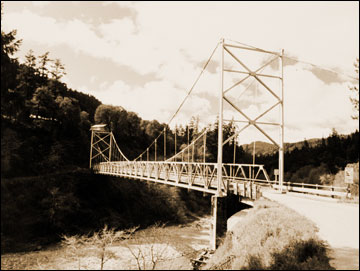|

We Villagers have our modern Bill Jackson Memorial Bridge, but it wasn't always so easy getting across the river.
In the early days, the Chimariko lived here. They traveled essentially the same route that follows the present road from
Hawkins Bar up into the New River area, and they used natural river crossings to get from one side of the Trinity to the other.
By the 1850s, five hundred or more New River gold miners had arrived and many struggled to open a supply route through
Hawkins Bar. (The original Hawkins Bar was where Trinity Village is today.) However, even as the gold rush subsided in 1875,
there still weren't any wagon roads, let alone a bridge, and all communication and supplies came by pack train.
A second gold rush began in the late 1880s, and since supplies were once again in high demand, Hawkins Bar became one
of the major trails into the area. Nonetheless, miners and residents managed without a bridge. One pioneer described carrying
the mail to Old Denny, "We put a wire cable across the Trinity River whereby we could, by a rope underneath the wire
and a cage to run back and forth, transmit across several hundred pounds."
The first bridge at Hawkins Bar was finally built between 1900 and 1904. It was a swinging bridge that cost approximately
$400 and could support about two tons, or a saddle horse and two loaded pack mules. A few years later, in 1919, the Forest
Service constructed a larger and stronger wagon bridge.
The big change came in 1939 and 1940, when the Civilian Conservation Corps, with the Army managing a crew of about 250
men installed a third Hawkins Bar bridge. This one was a metal suspension bridge, 200 yards long and 75 feet above the river.
This bridge had been previously used as a temorary bridge in the construction of Hoover Dam. It was reported at the time
in the Trinity Journal that this was "the largest bridge project accomplished by any CCC engineering crew in the United
States." There was a gold rivet, some say, being driven into the bridge during the dedication ceremony, but when it fell
into the river, a plain one had to be used instead.
When the wood deck of this bridge burned in 1954, a temporary bridge was brought in. Soon after, a flood washed out this
temporary bridge, leaving people with no way across the river. Repairs were accelerated on the metal suspension bridge, and
this time a new metal grating was to replace the old burnt wooden deck. Meanwhile, a hand-over-hand, self-propelled platform
called a skip was hung from a high line over the river to get material and people across. Children were even transported to
school high above the river on this skip until the repaired bridge was reopened in 1956.
Lezlee Heft grew up here and vividly remembers the old Denny Bridge. Originally it was bought used in Alaska, trucked
down here, and reassembled, she recalls, and it was all open metal. There was nothing solid about it. There were cat walks
on both sides so you could walk across too. If a logging truck came onto the bridge right behind you, the whole bridge would
start undulating up and down, and the sound of rubber tires going over the metal grating always sounded like an airplane taking
off.
As a girl, she and her family regularly rode horses across the bridge. You never knew what a horse would do the first
time you took it across. The horseshoes clanked on the grates, and you could look straight down to the see the river. Some
horses would rear, some would snort, and some would sort of squat down and splay out their feet, but they all got used to
it.
In 1972, although many protested the replacement of the beautiful, but very worn, old metal bridge, our current concrete
bridge was begun. Dedicated in 1980, the Bill Jackson Memorial Bridge was named for Lezlee's father, Trinity County native
William Chester Jackson. Bill was a deputy sheriff who was shot and killed in the line of duty while helping a transient who
was passing through Salyer. As a youth, Bill drove cattle up and down the New River to supply the miners and residents, and
later ran a hunter's pack station at Hobo Gulch. What Lezlee remembers most about Bill though is that he was loved by everybody.
|

